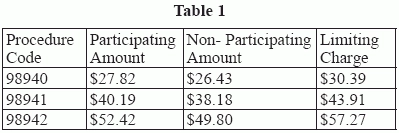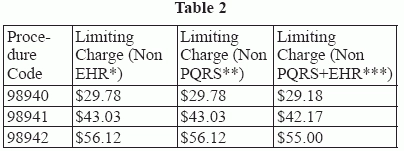Chiropractic Coding & Compliance Alert
Make the Most of 0.5 Percent Increase in Medicare Physician Fee Schedule

Noncompliance with EHR and PQRS to affect the non participating providers.
Get ready for the most important update of the year: the Medicare Physician Fee Schedule amounts increased by 0.5% effective January 1, 2016. What’s more, the Medicare Part B deductible for year 2016 is $166, according to Medicare contractor NGS, which covers the Wisconsin region.
“Yes, there is an increase,” affirms Doreen Boivin, CPC, CCA, with Chiro Practice, Inc., in Saco, Maine. “They can enjoy it for a short-lived time if they didn’t participate correctly in PQRS and EHR.”
Here’s a lowdown on the money involved as reimbursement for the most common procedure codes in chiropractic manual therapy.
Know How Much the CMT Codes Pay in 2016
The most common CPT® codes are covered by Medicare are 98940 (Chiropractic manipulative treatment [CMT]; spinal, 1-2 regions), 98941 (... 3-4 regions), and 98942 (… 5 regions). When it comes to money, participating and non-participating providers are entitled to different payments.
“I believe the majority did well,” says Boivin. According to the law, limiting charges apply to Medicare non-participating providers who did not accept assignment on a claim. Providers meeting this criteria who successfully participated in both the EHR and PQRS programs can use the limiting charge listed in Table 1.
Fall in Line With the Payment Adjusted Limiting Charge
Providers who did not implement EHR or failed to comply with PQRS in the determination of year 2014 will have to use the rates below.
*Non EHR: The non-par providers not accepting assignment who could not successfully participate in EHR to select this limiting charge
**Non PQRS: The non-par providers not accepting assignment who could not successfully participate in PQRS to select this limiting charge
*** (Non PQRS+EHR): The non-par providers not accepting assignment who could not successfully participate in both EHR and PQRS to select this limiting charge
A million questions: Is noncompliance going to result in a big loss or a moderate bearable decrease in the payment for the non performed DCs? Is this limiting charge worrisome? Is there anything they can do about this now?
Boivin answers: “The limiting charge has always been part of the program. Providers just need to pay attention to their reimbursements. Noncompliance will result in a moderate loss over time.”
Although NGS Medicare had initially released the fee schedule amounts for Wisconsin in late October 2015, they pulled this information off their website in the last week of December in order to correct “technical errors.” In fact, there was a 14-day hold on claims submitted for 2016 services, until Jan. 15, 2016, when the 2016 fee schedule amounts and limiting charges were made available on the NGS website.
Even then there were inconsistencies with the reduced limiting charge amounts, which only apply to non-par providers who do not accept assignment on claims and did not successfully participate in the PQRS and/or E.H.R. programs in 2014. This was because the reduced limiting charge amounts were not updated initially so as to reflect the increased penalties which now apply in 2016 (a 2 percent reduction to covered services for not doing either PQRS or EHR, and a 4 percent reduction for not doing both programs).
To download the 2016 Fee Schedule grid, go to www.wichiro.org/wpwca/wp-content/uploads/2016/01/2016_FEE_SCHEDULE_1.25.16.pdf
You can also use the fee schedule lookup tool located online at NGSMedicare.com
Impact to you: “Use your tools at hand,” advises Boivin. “This is your best defense to stay on top of things.”

Related Articles
Chiropractic Coding & Compliance Alert
- Reimbursement:
Join WCA In Their Fight Against Optum Per Diem Payment
Wisconsin OCI to scrutinize whether Optum limits access to quality chiropractic care. The WCA (Wisconsin [...] - Coding:
Wield Your Imaging Edge With the New X-ray CPT® Codes for 2016
Enjoy wider range of Code choices for spinal X-rays. There’s a lot to learn from [...] - Reimbursement:
Make the Most of 0.5 Percent Increase in Medicare Physician Fee Schedule
Noncompliance with EHR and PQRS to affect the non participating providers. Get ready for the [...] - ICD-10 Update:
Master the Cervical Disc Disorders in ICD-10
Choose your codes based on pathology and anatomical location Disc disorders are one of the [...] - You Be the Coder:
Coding the Second Encounter for a Neck Strain Patient
Question: A patient visits the office for a second time. She has the diagnosis of neck [...] - Reader Question:
CMT Codes Do Not Need Modifier 51
Question: A patient with a complaint of back pain presented to the doctor. After identifying subluxation, [...] - Reader Question:
Use Modifier 25 for Distinct Services
Question: The DC evaluated a new patient and performed chiropractic manipulative treatment in the same visit. [...] - Reader Question:
How to Request a PQRS Informal Review
Question: How is it possible to request for a PQRS informal review? Utah Subscriber Answer: As you [...] - Reader Question:
Figure Out the Cause of Denials
Question: Our claims are getting rejected for incorrect diagnoses. What could be the probable reasons for [...]




